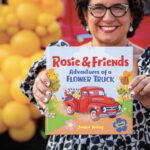
Photo by Dani Fresh.
Ingenuity, technology and creativity descended on Midtown Harrisburg recently.
The event, called MakerShift, brought area businesses, individuals and schools together to show off their STEAM (science, technology, engineering, arts and math) creations and capabilities.
“Our goal is to expose the public to the great creativity and innovation that’s happening in the region and celebrate that,” said Chad Frey, president of Foundry Makerspace, an organization that helps Harrisburg schools bring STEAM into the classroom.
Event venues, marked with balloon towers, ran up N. 3rd Street from St@rtup Harrisburg to the Susquehanna Art Museum.
Fourth-grader Sylvia Givler watched as a 3D printer crafted a Coffin’s cube—a three-dimensional puzzle.
“I just like it because it’s cool, and you can learn new stuff,” she said, remarking on the technology. “It’s tricky, and I like a challenge.”
Cinematographer Seth Umbenhauer stood next to a young man trying out the Vive virtual reality headset. Controllers in hand, he played a game called Longbow, pulling and releasing his imaginary bowstring, defending his castle against attackers.
“It’s great to see the community come together and celebrate creativity,” Umbenhauer said.
Just outside, Michael Peluso demonstrated the ancient art of glassmaking.
“There’s not a lot of forgiving things about glass—gravity is always working against you,” he explained as he moved the molten glass in circles. “You have an ally in centrifugal force.”
He allowed onlookers to use didymium glasses, which serve as eye protection and show the heat content of the glass. He also explained that minute amounts of metal oxide produce colors in glass.
Watching Peluso, Central Dauphin High School sophomore Jordan McBarnett described the connection between art and STEAM.
“As you know, art comes from everything; it’s universal,” he said. “We should appreciate and respect it. Art is in chemistry and engineering, and coding is a language.”
McBarnett is part of the robotics team, (In) Formal Logic, at Covenant Christian Academy. The group created a cubed robot that collects then shoots balls.
The Makers
The folks displaying their creations are called makers.
“That’s an individual who basically creates for the love of creating within the STEAM field,” said event volunteer Allen Fernandez. “They range from inventors to entrepreneurs and innovators.”
Frey said that, for 21st–century jobs, workers must be able to communicate and innovate. Projects like those represented at the MakerShift showed the adaptability necessary for employment and “design thinking, walking through a process of building and making,” he said.
Cases in point: Francis Davis, 16, and Emmitt Altland, 12.
Davis designed and constructed a diabetic travel kit in which insulin pens could be kept cold until used. Insulin pens are often wasted because they can’t be re–cooled after becoming warm, he said. He described his technological challenges with the project.
“I made a cube into a spike when I was trying to make a rectangle,” he said.
Altland was creating a pocketknife that automatically opened after taking it out of your pocket. He made a hook that caught on the pocket and activated the knife latch. His problems were more mechanical.
“I had to bend the wire, and it was difficult to keep the same shape,” he said.
Better Understanding
Businesses like Dillsburg-based Katapult Engineering need this type of original thinking. To help the inspiration along, the company has started a makerspace, Katapult Libratory, in the old Dillsburg Library.
Makerspaces allow like-minded STEAM folks to come, use the equipment, create and have fun. For those who can’t make it to the makerspace, Katapult provides the option of a MakeBox, a monthly project subscription.
The State Library of Pennsylvania also has a makerspace open to schools during the academic year and a full schedule of free classes for makers in the summer. This year’s theme is anatomy and physiology.
Frey praised the growth of STEAM, but said that the thinking around it needs to evolve. Makers, he said, have typically lived in large cities and been of higher socioeconomic status.
“A shift needs to start to think more democratically—not just men, not just white, not just with money,” he said.
Anyone attending the MakerShift would have seen a great deal of diversity and left with a better understanding of STEAM (remember the art!). They may have had a first-time experience with the Vive and an up-close and personal view of a 3D printer in action. More importantly, they would have walked away amazed at the ingenuity just under their noses in the capital region.
To learn more about Foundry Makerspace, visit www.foundrymakerspace.com.
Author: Susan Ryder





